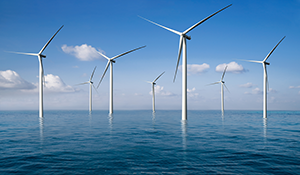As renewable energies take center stage in political policies and public consciousness, IMPLAN is here to help you measure each project’s economic impact. Our recent post Resource Roundup: IMPLAN and Solar Energy focused on giving you the information you need to study the economic impact of a solar energy project. Much of that same information can also be applied to wind power projects. In today’s blog, we’re taking a look at the Offshore Wind Tax Credit Program and how IMPLAN can help you understand the economic impact of wind energy projects, whether you’re a developer, a state authority, or an accounting service provider.

What tax credits are available for offshore wind projects?
In December 2020, U.S. Congress made the decision to implement a 30% Investment Tax Credit (ITC) for offshore wind farms. This ITC is an exciting incentive for developers of wind projects and can be applied to projects that start construction any time between 2017 and 2025. The intention of this federal incentive is to encourage innovation and lower the costs of creating clean energy, ultimately making it more affordable for consumers.
Meanwhile, there are also tax credits available on the state level. For example, the New Jersey Economic Redevelopment Act of 2020 (ERA) included updates to the Offshore Wind Economic Development Tax Credit Program, which provides reimbursement for capital investments in industry-specific facilities located in New Jersey.
Where do economic impacts come in?
Different programs have different requirements, but many of these tax credit programs require that credits only be awarded subject to a positive economic benefit. For example, the New Jersey program described above requires that the Authority granting the tax credit “must ensure fiscal prudency by determining that the award of tax credits creates a net positive economic benefit to the State.”
Both developers and state authorities can utilize IMPLAN in this process. In fact, NJEDA staff published a Net Economic Benefit Analysis Overview explaining how and why they use IMPLAN to calculate the expected net economic benefit from projects awarded within the ERA programs, namely the Offshore Wind Economic Development Tax Credit Program.
Meanwhile, organizations can stay one step ahead by presenting IMPLAN's economic impact analysis with the application to help obtain the credits. Alternatively, consultants can conduct IMPLAN studies on behalf of developers to help them win tax credits.
Studies Using IMPLAN
Let’s take a look at some studies that have been conducted by IMPLAN clients to explore the economic impact of different offshore wind development projects.
Please note: IMPLAN economist did not perform and have not reviewed these client studies.
NC Offshore Wind Cost Benefit Analysis: The Southeastern Wind Coalition, a 501(c)3 that works to advance the land-based and offshore wind industry in the Southeast, published this study in January 2022 to help decision makers in North Carolina quantify some of the environmental and economic benefits associated with offshore wind.
Economic and Fiscal Impacts of the Morro Bay Offshore (MBO) Wind Farm Project: This report analyzes a specific project in California. It calculates the impacts of a 765 megawatt floating offshore wind farm proposed by Trident Winds.
An Analysis of the Economic Impact of the Proposed 1,200MW Expansion of Maryland’s Offshore Wind Program: This analysis by Sage Policy Group, Inc. was commissioned by the BlueGreen Alliance. It explores the impacts of a prospective 1,200 MW expansion of Maryland’s offshore wind capacity as established in the proposed Clean Energy Jobs Act.
Evaluating Benefits of Offshore Wind Energy Projects in NEPA: This study was published by the U.S. Department of the Interior Bureau of Ocean Energy Management. BOEM must comply with the National Environmental Policy Act (NEPA) prior to approving a lessee’s construction and operation plan for a wind project. This white paper is about capturing “the beneficial effects that can accrue from the development of renewable energy sources.”
As you can see, IMPLAN clients use the software to explore the impacts of offshore wind in a variety of ways that are extremely relevant to tax credit programs. They look at the impact on the economy at large as well as more specific factors like the jobs created by a project.
Let’s Discuss Your Project
IMPLAN helps developers, state authorities, accounting service providers, and other organizations gain insight into how offshore wind projects impact the economy. A study using IMPLAN can help you capitalize on tax credits and so much more. To discuss your project and learn more about how IMPLAN can help you achieve your goals, schedule a demo today!



.png?width=80&name=IMPLAN_Logo_Print-Vector_NEW%20(2).png) Copyright 2025
Copyright 2025